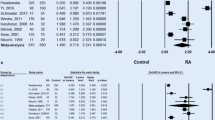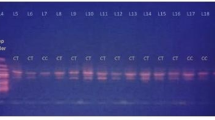Abstract
Vascular endothelial growth factor (VEGF) is known to be involved in the pathogenesis of rheumatoid arthritis (RA). In order to elucidate the association between VEGF levels and RA disease activity, VEGF concentrations were measured in RA patients at different phases and severity levels. Thirty-eight healthy subjects and 40 patients with RA were prospectively included in the study. Subjects were further categorized into four subgroups (high, moderate, low, or remission) using the disease activity score-28 (DAS28) scoring system. VEGF levels were significantly higher in patients than controls (p < 0.001). VEGF levels differed significantly in controls, early and late-phase RA patients (p = 0.002). A significant difference was found between controls and patients with high RA disease activity scores (p < 0.0001). VEGF levels were not correlated with age (r = −0.016; p = 0.921) or sex (r = 0.209; p = 0.921). VEGF values were correlated with erythrocyte sedimentation rate (r = 0.445; p = 0.004), but was not correlated with serum rheumatoid factor levels (r = −0.130; p = 0.424) in the patient group. In conclusion, higher VEGF levels are associated with late phase and high disease activity in RA, independent of age and sex.




Similar content being viewed by others
References
Koch AE, Harlow LA et al (1994) Vascular endothelial growth factor A cytokine modulating endothelial function in rheumatoid arthritis. J Immunol 152:4149–4156
Fava RA, Olsen NJ et al (1994) Vascular permeability factor/endothelial growth factor (VPF/VEGF): accumulation and expression in human synovial fluids and rheumatoid synovial tissue. J Exp Med 180:341–346
Kikuchi K, Kubo M et al (1998) Serum concentrations of vascular endothelial growth factor in collagen diseases. Br J Dermatol 139:1049–1051
Harada M, Mitsuyama K et al (1998) Vascular endothelial growth factor in patients with rheumatoid arthritis. Scand J Rheumalol 27:377–380
Paleolog EM (2009) The vasculature in rheumatoid arthritis: cause or consequence. Int J Exp Pathol 90(3):249–261
Yoo SA, Kwok SK, Kim WU (2008) Proinflammatory role of vascular endothelial growth factor in the pathogenesis of rheumatoid arthritis: prospects for therapeutic intervention. Mediators Inflamm Epub 2008:129873
Sone H, Sakauchi M et al (2001) Elevated levels of vascular endothelial growth factor in the sera of patients with rheumatoid arthritis correlation with disease activity. Life Sci 69:1861–1869
Ballara S, Taylor PC et al (2001) Raised serum vascular endothelial growth factor levels are associated with destructive change in inflammatory arthritis. Arthritis Rheum 44:2055–2064
Lee SS, Joo YS et al (2001) Vascular endothelial growth factor levels in the serum and synovial fluid of patients with rheumatoid arthritis. Clin Exp Rheumatol 19:321–324
Latour F, Zabraniecki L et al (2001) Does vascular endothelial growth factor in the rheumatoid synovium predict joint destruction? A clinical, radiological, and pathological study in 12 patients monitored for 10 years. Joint Bone Spine 68:493–498
Klimiuk PA, Sierakowski S et al (2002) Soluble adhesion molecules (ICAM-1, VCAM-1, and E-selectin) and vascular endothelial growth factor (VEGF) in patients with distinct variants of rheumatoid synovitis. Ann Rheum Dis 61:804–809
Drouart M, Saas P et al (2003) High serum vascular endothelial growth factor correlates with disease activity of spondylarthropathies. Clin Exp Immunol 132:158–162
Strunk J, Heinemann E, Neeck G, Schmidt KL, Lange U (2004) A new approach to studying angiogenesis in rheumatoid arthritis by means of power Doppler ultrasonography and measurement of serum vascular endothelial growth factor. Rheumatology (Oxford) 43:1480–1483
Ardicoglu O, Boz K et al (2004) Levels of vascular endothelial growth factor in patients with rheumatoid arthritis. The Pain Clinic 16:187–191
Pinheiro GR, Andrade CA et al (2001) Serum vascular endothelial growth factor in late rheumatoid arthritis. Clin Exp Rheumatol 19:721–723
Kuryliszyn-Moskal A, Klimiuk PA, Sierakowski S, Ciolkiewicz M (2005) A study on vascular endothelial growth factor and endothelin-1 in patients with extra-articular involvement of rheumatoid arthritis. Clin Rheumatol 25:314–319
Clavel G, Bessis N et al (2007) Angiogenesis markers (VEGF, soluble receptor of VEGF and angiopoietin-1) in very early arthritis and their association with inflammation and joint destruction. Clin Immunol 124:158–164
Choi ST, Kim JH, Seok JY, Park YB, Lee SK (2009) Therapeutic effect of anti-vascular endothelial growth factor receptor I antibody in the established collagen-induced arthritis mouse model. Clin Rheumatol 28(3):333–337
Taylor PC (2005) Serum vascular markers and vascular imaging in assessment of rheumatoid arthritis disease activity and response to therapy. Rheumatology(Oxford) 44(6):721–728
Firestein GS (1999) Starving the synovium:angiogenesis and inflammation in rheumatoid arthritis. J Clin Invest 103:3–4
Smolen JS, Breedveld FC et al (2003) A simplified disease activity index for rheumatoid arthritis for use in clinical practice. Rheumatology 42(2):244–257
Hormbrey E, Gillespie P et al (2002) A critical review of vascular endothelial growth factor (VEGF) analysis in peripheral blood. Is the current literature meaningful. Clin Exp Metastasis 19(8):651–663
Costa C, Incio J, Soares R (2007) Angiogenesis and chronic inflammation: cause or consequence? Angiogenesis 10(3):149–166
Paleolog EM, Young S et al (1998) Modulation of angiogenic vascular endothelial growth factor by tumor necrosis factor alpha and interleukin-1 in rheumatoid arthritis. Arthritis Rheum 41(7):1258–1265
Nagashima M, Wauke K et al (2000) Effects of combination of anti-rheumatic drugs on the production of vascular endothelial growth factor and basic fibroblast growth factor in cultured synoviocytes and patients with rheumatoid arthritis. Rheumatology (Oxford) 39:1255–1262
Pandya NM, Dhalla NS, Santani DD (2006) Angiogenesis—a new target for future therapy. Vascul Pharmacol 44:265–274
Kurosaka D, Hirai K et al (2009) Correlation between synovial blood flow signals and serum vascular endothelial growth factor levels in patients with refractory rheumatoid arthritis. Mod Rheumatol 19(2):187–191
Disclosures
None
Author information
Authors and Affiliations
Corresponding author
Rights and permissions
About this article
Cite this article
Ozgonenel, L., Cetin, E., Tutun, S. et al. The relation of serum vascular endothelial growth factor level with disease duration and activity in patients with rheumatoid arthritis. Clin Rheumatol 29, 473–477 (2010). https://doi.org/10.1007/s10067-009-1343-4
Received:
Revised:
Accepted:
Published:
Issue Date:
DOI: https://doi.org/10.1007/s10067-009-1343-4




